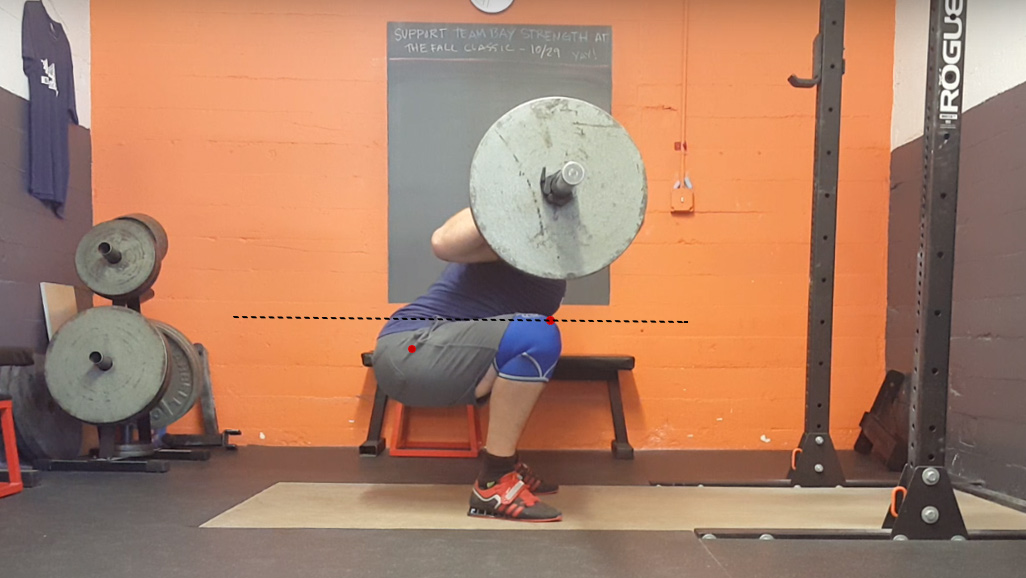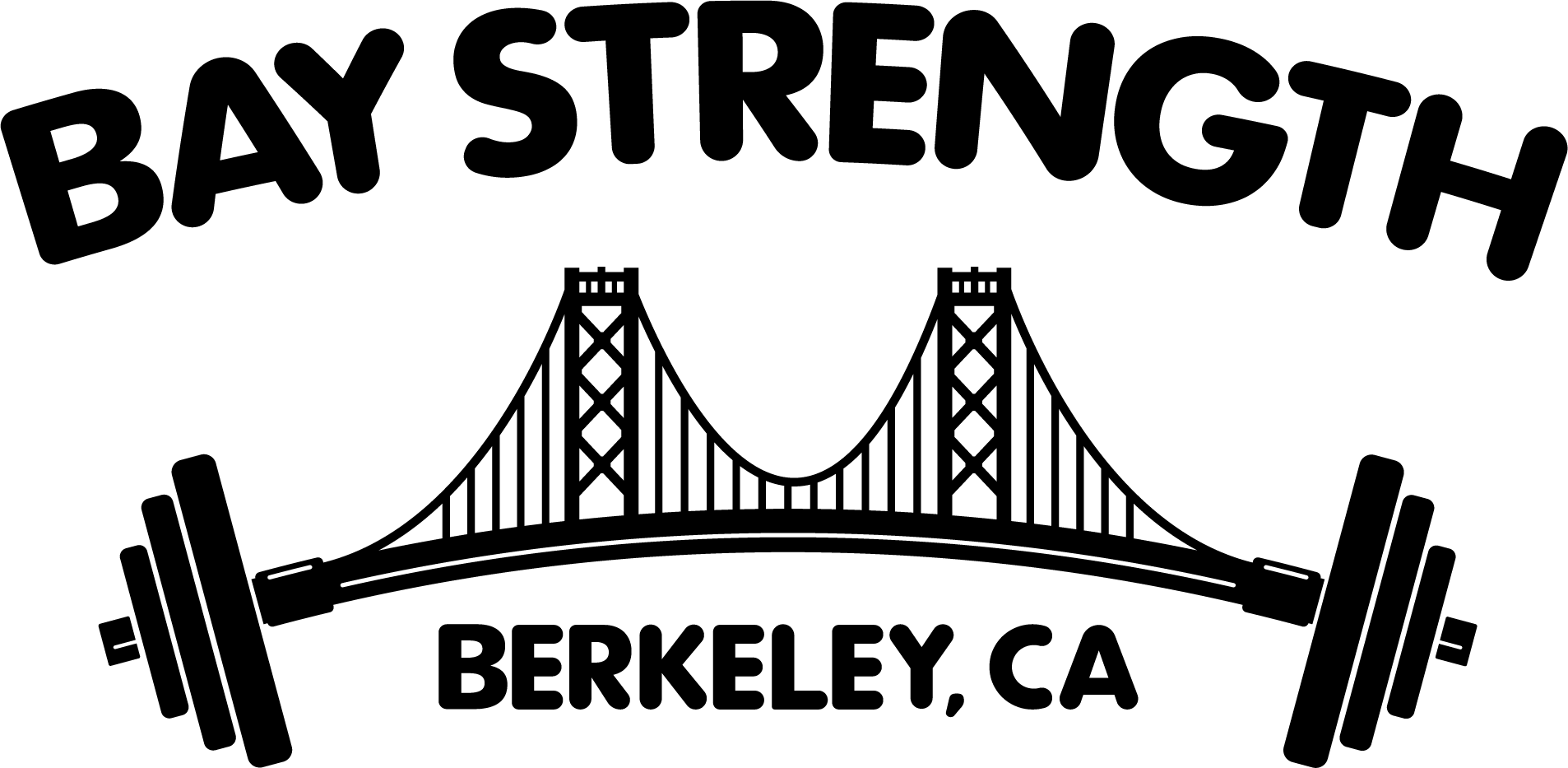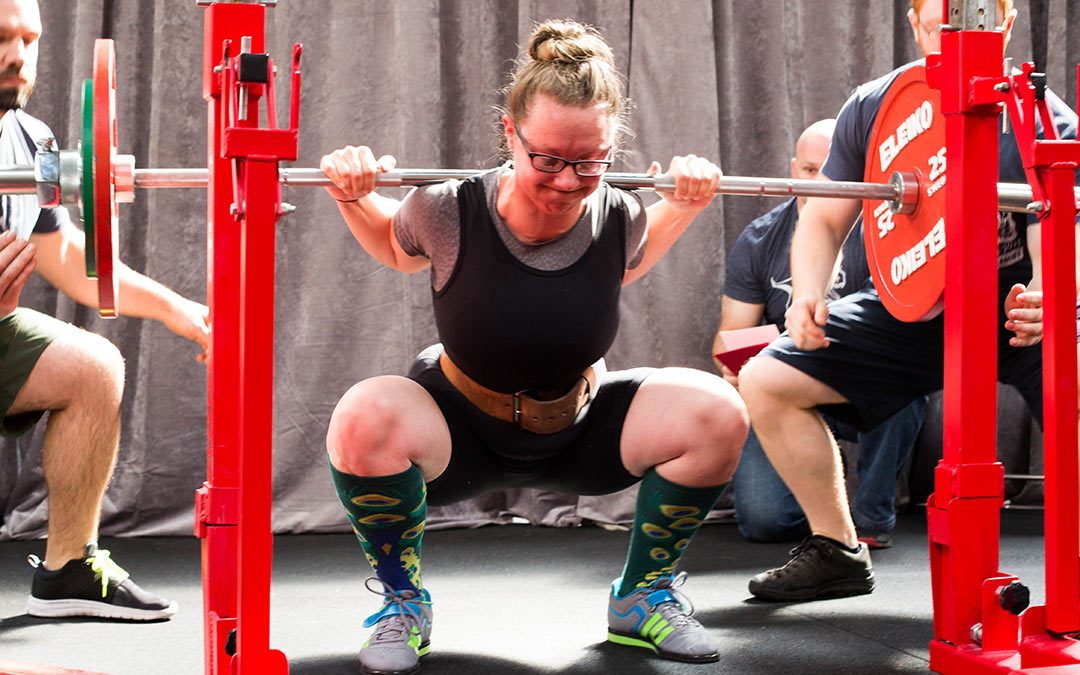Achieving full depth in the squat is critical to effective strength training. Squatting through the greatest effective range of motion best builds useful strength. Full depth squats, in which the lifter goes below parallel — the hip joint dropping below the top of the knee — are also important for safety: partial squats produce unbalanced forces across the knee, whereas correctly performed full depth squats produce balanced forces across the knee.
One challenge new lifters face is knowing where full depth is. This blog post will help you verify that you are achieving full depth, and offer fixes to some common problems that you can implement if you are having trouble.
Verifying full depth
The first step to squatting to full depth consistently is to verify your depth. This photo shows an example of full depth, with the hip joint unambiguously lower than the top of the knee:

In this squat, the lifter’s hip joint is clearly below the top of their knee.
The best way to verify your depth is in real time with the help of a qualified coach who is watching your warmup and work sets. They can quickly make an accurate determination and cue you while you are performing the movement. Real time feedback will accelerate the process by which you improve your proprioceptive awareness and are able to consistently achieve full depth.
The next best option is with the help of a lifting buddy. They can play the role of coach, giving you real time feedback during your set. If you are relying on a lifting buddy, make sure they know what full depth is! Show them this blog post and the above example of full depth.
A third option is to video yourself. In the absence of a coach or lifting buddy, you should be recording and reviewing all your sets to confirm that you are squatting all the way down. This is not as good as having someone cue you in real time, but it is certainly better than nothing. When videoing yourself, do your best to do the following:
- Place your phone at or just above hip height when you are at the bottom of the squat.
- Place your phone so that the angle is 45 degrees rear oblique. This is the single most useful angle for video review of a set.
- Make sure there is adequate lighting, and avoid dark pants or shorts — they can make it harder to see fine details on video.
Problems and fixes
What do you do if you’re having trouble consistently achieving full depth? Below are some possible reasons and solutions you can explore. Note that this is not an exhaustive list, and as always, a coach can help you determine what the exact problem is and how to address it.
Technique
There are a few technical reasons that a lifter will have trouble achieving full depth. One very common reason is using a stance that is either too narrow or too wide. A stance that is too narrow will result in the lifter’s thighs jamming into their belly before they get all the way down. A stance that is too wide will cause the lifter’s hamstrings and/or adductors to reach the end of their extensibility prior to achieving full depth.
For most lifters, a stance that is about shoulder width — give or take an inch or two — and toes out 30 degrees will work. Adjustment may be necessary depending on individual anthropometry.
Another common cause of high squats is a failure to push the knees out to the sides so that they track over the toes. As with a narrow stance, this will result in the lifter’s thighs jamming into their torso and preventing them from achieving full depth. Pushing the knees out, especially under a heavy weight, is difficult due to the tension on the inside of the thighs. If this is your problem, resolve to aggressively shove your knees out of the way as soon as you start your descent.
A third error that can result in shallow squats is when lifters allow their weight to shift toward the front of their foot. Being off balance forward will often prevent a lifter from achieving full depth (in addition to causing a host of other problems). In these cases, some generally useful cues involve feeling your mid-foot — or even thinking about your heels, if the problem is really bad — and staying back in your hips.
Proprioceptive
Some lifters have a harder time feeling where the bottom of the squat is. Real time cueing with a coach or lifting buddy is most useful in addressing this problem.
If that is not an option, try this drill that I have found effective with some lifters:
- Without the bar, take your normal squat stance, and squat all the way down to the bottom position and hold it.
- Using a mirror (gasp!), confirm that you are at full depth. This is perhaps the only time a mirror is useful with regard to the squat.
- Look away from the mirror and focus on feeling that position, paying particular attention to the feeling in your hips.
- Stand back up (using hip drive, of course) and do your set.
You may consider repeating this drill before every set until you are consistently achieving full depth.
Psychological
Some lifts have a greater propensity to cause an “Oh, shit!” moment of panic for new lifters. For many people, it is the lifts in which the bar is on top of you: the squat and the bench press.
There may not be a one size fits all solution to this problem, and an effective approach must be tailored to the individual. That said, here are some general things you can try:
- Work on putting yourself in an aggressive mindstate prior to beginning your set and before each rep. Carry yourself confidently before the set. Your physical posture affects your mental state.
As you’re getting ready to get under the bar for your set, vocally cheer yourself on. A loud, “Let’s go!” to yourself can help increase your confidence going into the set, as can aggressively and confidently setting up for the set.
Between reps, keep your confidence up. Getting mad, or making an angry or intense face before each rep can help. - If it is within your control (you are training in a home gym or lift with wireless headphones on), choice of music helps. Whatever makes you feel most confident is good. Some people prefer loud and aggressive. Coach Katherine loves Katy Perry!
- If none of the above help you, and your anxiety about getting stuck at the bottom is really bad, you might even try deliberately failing a rep onto the spotter arms. Do this with a weight that is lighter than your work weight. Sometimes, this can help to convince your brain that everything will be okay even if you miss your rep, and therefore make you more willing to get all the way down during your work sets.
A note on excessive depth
While you should demand full depth of yourself on every rep, be careful not to go too deep. Your working reps should be without a doubt below parallel. More than a couple inches below parallel is excessive, however. Going excessively deep — doing an “ass to grass” squat — will typically result in other technique errors, such as coming up on your toes, allowing your knees to cave in towards each other, lumbar spinal flexion, and generally losing tightness.
You may want to have two different depth standards for regular training and for competing in a lifting meet. In the former, you want to squat just an inch or two below parallel. In the latter, you’ll have to convince judges who will be told to assume you’re squatting high — so you will want to get another inch lower than you normally would in train, in order to erase all doubt.

